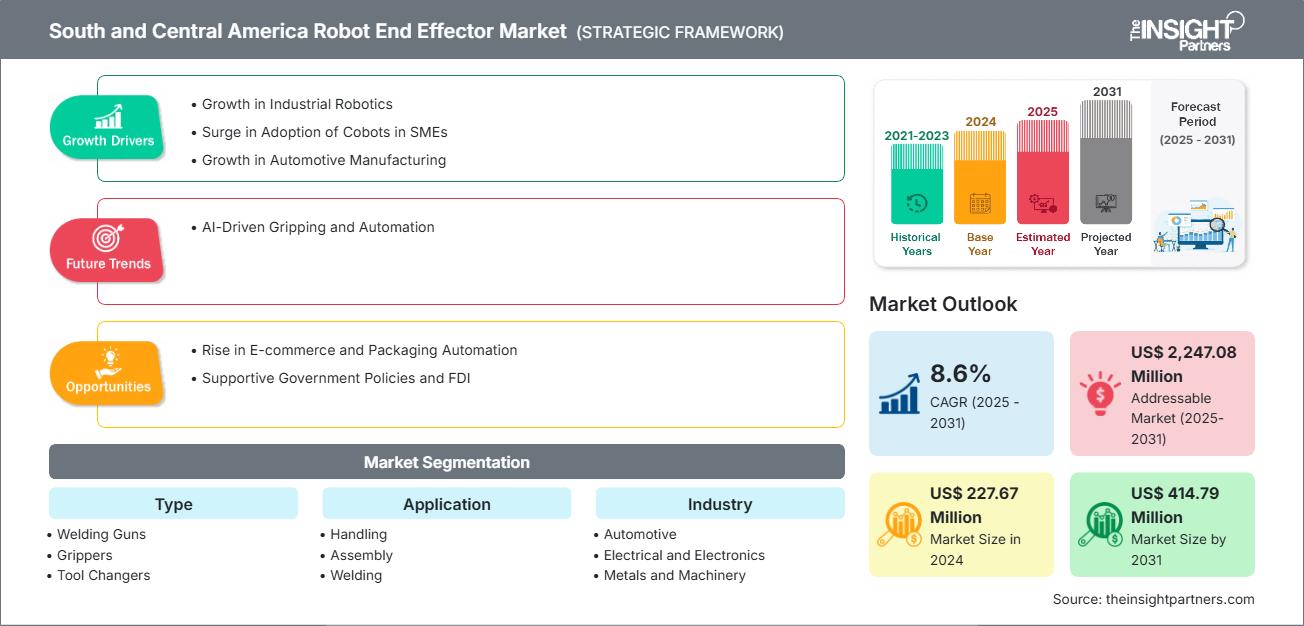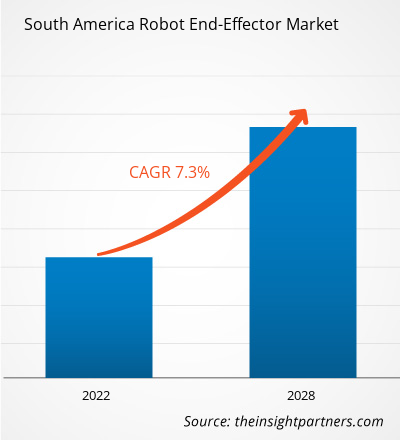南美和中美机器人末端执行器市场规模预计在 2024 年达到 2.2767 亿美元,预计到 2031 年将达到 4.1479 亿美元。预计该市场在 2025-2031 年期间的复合年增长率为 8.6%。end-effector Market size is projected to reach US$ 227.67 million in 2024 and is projected to reach US$ 414.79 million by 2031. The market is expected to register a CAGR of 8.6% during 2025–2031.
南美和中美机器人末端执行器市场分析End-Effector Market Analysis
南美和中美洲农业产业的扩张促进了机器人末端执行器的应用,以改进收割作业。机器人系统中使用柔性夹爪来收割、修剪和分拣咖啡、葡萄和大豆等作物。这些装置模仿人手的精准度和灵活性,非常适合需要精细操作的活动,例如收割水果和蔬菜。在智利和哥伦比亚等国家,机械臂上安装了专用夹爪,以帮助工人轻柔地处理娇嫩的水果,从而减少水果腐烂并提高出口质量。
南美和中美机器人末端执行器市场概况
机器人末端执行器安装在机械臂末端,可直接与物体、材料或工具交互以执行特定任务。它通常被称为机器人的“手”,因为它决定了机器人的功能和应用。根据任务的不同,末端执行器可以采用多种形式,例如夹持器、吸盘、焊枪、切割工具、喷枪或专用传感器。机器人末端执行器在推动制造业、汽车业、电子业、物流业、包装业和医疗保健业等行业的自动化、效率和质量方面发挥着核心作用。在制造业中,夹持器使机器人能够精确地组装零件或在生产线上搬运产品。在物流业中,真空夹持器用于电子商务配送中心的自动化拣选和包装,从而降低人工成本并提高吞吐量。
您可以免费定制任何报告,包括本报告的部分内容、国家级分析、Excel 数据包,以及为初创企业和大学提供优惠和折扣
南美和中美机器人末端执行器市场:战略洞察

- 获取此报告的顶级关键市场趋势。此免费样品将包括数据分析,从市场趋势到估计和预测。
南美和中美机器人末端执行器市场驱动因素和机遇
市场驱动因素:
工业机器人在各行业的扩展
工业机器人在制造业、建筑业、医疗业以及食品饮料业等行业获得了显著发展,这推动了全球对机器人末端执行器的需求。根据国际机器人联合会 (IFR) 的数据,截至 2024 年 9 月,最新发布的《世界机器人报告》显示,全球工厂中运行的工业机器人数量为 4,281,585 台,同比增长 10%。年安装量连续第三年超过 50 万台。按地区划分,2023 年新增部署的机器人中有 10% 安装在美洲地区。
市场参与者的投资组合扩张
工业机器人公司正在采取战略举措,以提升市场前景。2025年6月,ABB机器人公司扩展了其大型工业机器人产品组合,推出三款全新型号:IRB 6730S、IRB 6750S和IRB 6760。这些新增产品,加上自2022年以来推出的更广泛的下一代机器人系列,使ABB成为业内功能最丰富的机器人产品线之一。该公司的产品目前包括11个下一代机器人系列,共计60种型号,提供更高的灵活性、性能和可持续性,以满足现代制造业的多样化需求。随着工业机器人在各个行业的扩展,机器人末端执行器制造商在全球范围内日益受到关注,推动着市场增长。
市场机会:
中小企业采用协作机器人数量激增
移动协作机器人 (cobot) 因其经济实惠、灵活性高且易于集成到现有运营中,非常适合中小企业 (SME) 的需求。传统工业机器人需要大量的前期投资和复杂的基础设施。而移动协作机器人则提供可扩展的自动化解决方案,能够满足小型企业的预算限制和运营现实。它们拥有用户友好的设计和直观的编程界面,并能够适应多样化的工作流程,即使是技术专业知识有限的公司也能轻松上手。汽车行业应用日益广泛
在高度自动化的汽车生产线中,焊接、喷漆、材料处理和部件装配等关键工序都依赖于可在苛刻条件下提供稳定性能的特定应用末端执行器。这些工具对于保持精度、缩短周期时间和最大限度减少生产停机时间至关重要。这些因素对于满足全球汽车市场严格的质量和产量标准至关重要。为了保持竞争力,原始设备制造商 (OEM) 正在部署配备力控制、传感器集成和快速更换功能的智能末端执行器。这些功能可以更灵活地处理不同的型号和组件。它们支持更敏捷的制造策略,如混合模式生产和准时 (JIT) 装配。随着向电动汽车 (EV) 和轻量化材料的转变,对先进的、适应性强的末端执行器的需求正在上升,这使得它们成为南美洲和中美洲不断发展的汽车制造业格局中的关键资产。
南美和中美机器人末端执行器市场报告细分分析
为了更清晰地了解南美和中美机器人末端执行器市场运作方式、增长潜力和最新趋势,我们将市场细分为不同的细分领域。以下是大多数行业报告中使用的标准细分方法:
按类型
焊枪
焊枪是一种便携式设备,用于在金属件上实现自动和半自动焊接。焊工可以使用焊枪进行多种工艺,包括点焊、电弧焊和电子束焊。因此,焊枪/焊炬已成为非常高效的机器人末端执行器,可用于以复杂的方式控制焊接过程。夹持器
夹持器的主要功能是将某种形式的动力转化为机器人手指的抓取动作。动力输入可以通过气动、液压或电动方式提供。夹持器是最常见的机器人末端执行器类型。工具更换器
工具更换器允许单个机器人根据需要切换和使用不同的机器人末端执行器。这些工具更换器用于标准化机器人法兰和工具底座之间的接口。工具更换器可以是手动或自动的。它们坚固耐用,能够管理连续的更换操作,同时保持可靠性和安全性。制造机器人工具更换器的公司包括 DESTACO(都福集团)和 Zimmer 集团。夹具
机器人夹具专为机械臂或基于机械臂的项目而设计。它们适用于商业和工业用途。机器人夹具越来越多地被流程工业和离散工业所采用,以确保装配线的生产过程顺利进行。吸盘
吸盘在手动或自动搬运应用中用作夹持器。它们可以固定并帮助移动各种产品,从瓶子、袋子到砖块、木板、金属板、管道和玻璃窗。真空或吸盘广泛应用于包装、食品、木工、金属加工、饮料、半导体、汽车和电子等行业。它们能够在高速运动的应用中牢固地抓取部件,并能轻柔地搬运易碎部件。真空
真空机器人末端执行器是一种专用抓取工具,广泛应用于自动化系统,用于抓取表面平坦或光滑的产品。它通过真空泵或文丘里系统产生的吸力进行工作。现代真空夹持器通常集成传感器和视觉系统。这增强了其调节吸力水平和适应不同产品几何形状的能力。其他的
其他部分包括力矩传感器、喷漆工具、铣削等。喷漆机器人工具与其他自动喷漆设备配合使用,可最大限度地提高喷漆效率和漆面一致性。
按应用
处理
诸如拾放之类的搬运任务涉及将物体从一个位置移动到另一个位置。处理危险品的末端执行器必须具备极强的抗断电和断电能力。这项任务需要精准度以及安全搬运物体的能力,无论物体由何种材料制成,也无论其多么易碎。除了拾放之外,物料搬运主要用于制粒和包装。集会
装配任务涉及逐步构建产品,需要机器人末端执行器来处理各种尺寸和形状的零件。机器人可以交替处理木质、塑料或金属零件,并进行相应调整,从而持续生产出缺陷率最低的高质量产品。焊接
机器人焊接广泛应用于汽车等大批量生产行业,尤其适用于电阻点焊和电弧焊。自动化电弧焊解决方案的开发源于对更高产品质量、更高生产效率和更低成本的需求。分配
机器人点胶非常适合将粘合剂、密封剂和润滑剂等物质输送到预定位置,即使面对复杂的轮廓或曲线也能轻松应对。相比直接点胶,从上方点胶到表面,点胶材料流动性更好。由于机器人点胶机每次喷出的胶量一致,制造商可以获得诸多优势,例如胶珠路径精准、节省材料用量、提高产品质量、提升产量和安全性。加工
如果没有机械臂,流程就无法实现自动化和优化,但机器人的末端执行器却使机器人能够执行任务。机器人末端执行器是用作工艺工具或传感器的机械或机电设备。工具用于对工件执行加工操作。点焊、弧焊和喷漆应用广泛。其他的
其他环节包括涂层、材料去除和表面精加工。机器人通常配备涂层,以防止油漆积聚在手臂表面。这层涂层是消耗品,更换相对容易。它是机器人维护程序的一部分。先进的扭矩或力传感器以及灵活的夹爪使产品测试自动化成为可能。它确保在小心处理产品的同时保持高质量。负责材料去除的机器人有两种类型:一种是设计用于拾取零件并将其送至切割机的机器人,另一种是设计用于操作切割机或其他材料去除设备的机器人。最后,表面精加工是一个需要灵活性的工艺。它是生产线中比较脏的工序之一,这使得它非常适合自动化。机器人可以有效完成的表面精加工工艺包括打磨、抛光和打磨。这些工艺可以应用于各种材料,从塑料、金属、木材到大理石和碳纤维。
按行业垂直
- 汽车
- 金属和机械
- 电气和电子
- 食品和饮料
- 零售和电子商务
- 其他的
按地理位置
南美洲和中美洲
南美和中美洲的机器人末端执行器市场是全球最大的市场,受消费者汽车普及率不断上升以及汽车制造商生产活动不断增加的推动,这些因素刺激了对机器人末端执行器的需求。汽车制造商使用夹持器、焊枪、吸盘和喷漆喷嘴来提高制造精度、效率和安全性。这些机器人工具与机械臂连接,以无与伦比的一致性和速度执行焊接、喷漆、物料搬运和装配等操作。
南美和中美机器人末端执行器市场区域洞察
Insight Partners 的分析师已详尽阐述了预测期内影响南美和中美机器人末端执行器市场的区域趋势和因素。本节还讨论了南美和中美机器人末端执行器市场在北美、欧洲、亚太地区、中东和非洲以及南美和中美的细分市场和地域分布。
南美和中美机器人末端执行器市场报告范围
| 报告属性 | 细节 |
|---|---|
| 2024年的市场规模 | 2.2767亿美元 |
| 2031年的市场规模 | 4.1479亿美元 |
| 全球复合年增长率(2025-2031) | 8.6% |
| 史料 | 2021-2023 |
| 预测期 | 2025-2031 |
| 涵盖的领域 | 按类型
|
| 覆盖地区和国家 | 南美洲和中美洲
|
| 市场领导者和主要公司简介 |
|
南美和中美机器人末端执行器市场参与者密度:了解其对商业动态的影响
南美和中美机器人末端执行器市场正在快速增长,这得益于终端用户需求的不断增长,而这些需求的驱动因素包括消费者偏好的演变、技术进步以及对产品优势的认知度的提升。随着需求的增长,企业正在扩展产品线,不断创新以满足消费者需求,并抓住新兴趋势,从而进一步推动市场增长。

- 获取南美和中美机器人末端执行器市场顶级关键参与者概览
南美和中美机器人末端执行器市场份额(按国家/地区)分析
南美和中美地区正成为机器人末端执行器增长最快的市场之一,这得益于农业产业的扩张,以及机器人末端执行器的应用增加,从而提升了收割作业效率。巴西、阿根廷、智利、秘鲁、哥伦比亚等国的汽车产量不断增长,电动汽车产业蓬勃发展,消费者对可持续汽车的需求也日益高涨。以下是各国家/地区市场份额和趋势的总结:
南美洲和中美洲
市场份额
市场稳步增长关键驱动因素
- 工业机器人在各行业的扩展
- 中小企业采用协作机器人数量激增
趋势
人工智能驱动的抓取和自动化。
南美和中美机器人末端执行器市场参与者密度了解其对商业动态的影响
市场密度高,竞争激烈
由于 Festo SE & Co. KG、ABB Ltd、J. Schmalz GmbH、Kuka AG 和 Piab AB 等知名企业的存在,竞争十分激烈。此外,雄克集团 (SCHUNK GmbH & Co. KG)、Zimmer 集团、DESTACO、史陶比尔国际股份公司 (Stäubli International AG) 和 SMC 公司等区域性和专业性供应商也为市场注入了活力和竞争态势。
这种激烈的竞争促使公司通过提供以下产品脱颖而出:
- 先进的末端执行器技术(例如,人工智能驱动的自适应夹持器、力扭矩传感和视觉引导系统)
- 多行业兼容性(支持汽车、电子、食品饮料和物流应用)
- 符合区域和国际标准(ISO、OSHA 和行业特定法规)的合规性解决方案
- 高速自动化功能以及与机器人系统的用户友好集成
机遇与战略举措
- 与自动化解决方案提供商、制造公司和工业机器人公司的合作对于市场渗透和创新至关重要。
- 模块化和可定制的末端执行器越来越受到人们的青睐,可以满足多样化的工业需求,同时提高成本效率。
- 向新兴制造业中心(巴西、墨西哥、阿根廷、哥伦比亚)的扩张正在推动增长,尤其是汽车、电子和食品加工行业的增长。
- 对智能夹持器、人工智能驱动的自适应末端执行器和支持物联网的执行器系统的研发投资正在提高精度、灵活性和自动化能力。
- 与协作机器人 (cobots)、工业物联网 (IIoT) 和自动化生产线的集成正在提高效率和运营可扩展性。
在南美和中美机器人末端执行器市场运营的主要公司有:
- 费斯托股份两合公司
- ABB有限公司
- J. Schmalz 有限公司
- 库卡股份公司
- 皮亚布公司
- 雄克有限公司
- 齐默集团
- 德斯塔科
- 史陶比尔国际股份公司
- SMC公司
免责声明:以上列出的公司没有按照任何特定顺序排列。
研究过程中分析的其他公司:
- 安川电机株式会社
- OnRobot公司
- 魏斯机器人有限公司
- IPR – 机器人智能外围设备有限公司
- Shobai Automation Pvt. Ltd.
- Beckhoff 自动化有限公司
- 易格斯有限公司
- 安弗公司
- 发那科公司
- 汉斯·图尔克有限公司
南美和中美机器人末端执行器市场新闻和最新发展
SMC公司推出新型工具快换装置系列
SMC公司推出了两款全新换刀器系列:RMTM和RMTA,旨在提升协作机器人的多功能性和效率。最新解决方案旨在满足特定的自动化换刀需求,并包含手动和自动换刀功能。Oxipital AI 与史陶比尔机器人公司合作,实现食品安全拣选
Oxipital AI 与史陶比尔机器人公司 (Stäubli Robotics) 合作,共同研发食品安全拣选技术。此次与史陶比尔的合作巩固了双方的共同努力,通过利用人工智能视觉解决方案以及卫生高速的机器人解决方案,帮助制造商克服食品加工过程中的一些最棘手的挑战。Zimmer 集团欣然宣布其新生产基地正式投入运营
Zimmer 集团欣然宣布,其位于莱茵瑙总部的新生产基地正式启用。这座现代化的新大楼将于七月初正式启用,这将使 Zimmer 集团的产能再增加 5,000 平方米,并为新成立的子公司 Zimmer Systems GmbH 提供进一步发展的理想条件。Piab 宣布扩大其广受好评的开袋杯产品线
Piab 欣然宣布,其备受赞誉的开袋杯系列再添新品,推出 18 毫米和 42 毫米两种新尺寸。这些新增尺寸与现有的 26 毫米和 33 毫米尺寸相得益彰,在各种应用中处理精细材料时,可提供更强大的多功能性和更精准的精度。
南美和中美机器人末端执行器市场报告覆盖范围和交付成果
《南美和中美机器人末端执行器市场规模和预测(2021-2031)》报告对以下领域进行了详细的市场分析:
- 南美和中美机器人末端执行器市场规模以及涵盖范围内所有关键细分市场的全球、区域和国家层面的预测
- 南美和中美机器人末端执行器市场趋势,以及市场动态,如驱动因素、限制因素和关键机遇
- 详细的 PEST 和 SWOT 分析
- 南美和中美机器人末端执行器市场分析涵盖主要市场趋势、全球和区域框架、主要参与者、法规和最新市场发展
- 行业格局和竞争分析,涵盖市场集中度、热图分析、知名参与者以及南美和中美机器人末端执行器市场的最新发展
- 详细的公司简介
- 历史分析(2 年)、基准年、预测(7 年)及复合年增长率
- PEST和SWOT分析
- 市场规模、价值/数量 - 全球、区域、国家
- 行业和竞争格局
- Excel 数据集
近期报告
客户评价
购买理由
- 明智的决策
- 了解市场动态
- 竞争分析
- 客户洞察
- 市场预测
- 风险规避
- 战略规划
- 投资论证
- 识别新兴市场
- 优化营销策略
- 提升运营效率
- 顺应监管趋势




















 获取免费样品 - 南美和中美机器人末端执行器市场
获取免费样品 - 南美和中美机器人末端执行器市场